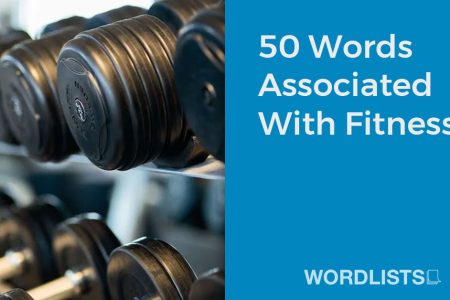Fitness is an important aspect of health and wellness, and there are many different ways to stay active and healthy. From running and lifting weights to yoga and dancing, there are endless options for incorporating fitness into your life.
There are also many words associated with fitness that help us describe and understand this concept. From terms for different types of exercise and fitness equipment to words that describe the benefits and goals of a fit lifestyle, this list of 50 words will give you a greater appreciation for the importance of staying active and healthy.

Subscribe to our mailing list to receive FREE exclusive content and offers!
50 Words Associated With Fitness Meanings
Exercise: This is a physical activity that is done to become stronger and healthier. It involves engaging in physical activity and increasing the heart rate beyond resting levels.
Physical activity: This is any movement that uses your muscles and expends energy. It includes everything from running and swimming to walking to work and cleaning your house.
Workout: This is a session of vigorous physical exercise or training.
Training: This is the process of teaching or learning a skill or job, or the process of being taught. In the context of fitness, it often refers to the process of systematically exercising or practicing in order to improve physical fitness or skill in a sport.
Strength: This is a measure of how much force your muscles can exert. In the context of fitness, it often refers to the amount of weight that can be lifted, or how long a difficult exercise can be performed.
Cardio: Short for cardiovascular exercise, it refers to any activity that increases heart rate and blood circulation. Examples include running, swimming, and cycling.
Aerobic: This type of exercise depends on oxygen to meet energy demands during exercise via aerobic metabolism. It includes activities like long-distance running, swimming, cycling, and walking.
Anaerobic: This type of exercise involves quick bursts of energy and is performed at maximum effort for a short time. Examples include weightlifting, sprinting, and high-intensity interval training.
Endurance: This is the ability to sustain prolonged physical or mental effort. In fitness, it often refers to the ability to keep up an activity (like running or cycling) over a long period of time.
Flexibility: This is the range of motion in a joint or series of joints, and length in muscles that cross the joints to induce a bending movement or motion.
Agility: This is the ability to move quickly and easily, often changing direction quickly. It’s important in many sports and physical activities.
Balance: This is the ability to maintain a controlled body position during task performance, whether it is sitting, standing, or moving.
Coordination: This is the ability to use different parts of the body smoothly and efficiently together. It often refers to the ability to move two or more body parts under control, smoothly and efficiently.
Power: In fitness, power refers to the ability to exert maximum force as quickly as possible, as in jumping, accelerating, or lifting weights.
Speed: This is the ability to move quickly across the ground or move limbs rapidly to grab or throw.
Plyometrics: Also known as “jump training” or “plyos”, these are exercises in which muscles exert maximum force in short intervals of time, with the goal of increasing power.
Resistance: This is the act of working against force. Resistance exercises are ones that work to strengthen muscles, such as weightlifting or bodyweight exercises.
Weight: In fitness, weight often refers to the resistance used to challenge muscles, such as dumbbells, kettlebells, or your own body weight.
Repetition: Often shortened to “rep”, this is the act of performing a specific exercise movement once. For example, one squat or one bicep curl would be considered one repetition.
Set: This is a group of repetitions performed without resting. For example, 12 repetitions of bicep curls might be considered one set.
Circuit: This is a form of body conditioning or resistance training using high-intensity aerobics. It targets strength building and muscular endurance, usually consisting of a cycle of exercises performed in a pre-determined order.
Interval: This refers to a type of training that involves a series of low- to high-intensity workouts interspersed with rest or relief periods.
Tabata: This is a form of high-intensity interval training, where workouts last four minutes. It consists of eight rounds of ultra-high-intensity exercises in a specific 20-seconds-on, 10-seconds-off interval.
HIIT: Short for High-Intensity Interval Training, this is a form of interval training where short periods of intense exercise are alternated with less intense recovery periods.
CrossFit: This is a branded fitness regimen created by Greg Glassman. It is a high-intensity fitness program incorporating elements from several sports and types of exercise.
Yoga: This is a group of physical, mental, and spiritual practices or disciplines that originated in ancient India. It often involves a series of postures and breathing exercises practiced to achieve control of the body and mind.
Pilates: This is a physical fitness system developed in the early 20th century by Joseph Pilates. It emphasizes proper postural alignment, core strength, and muscle balance.
Barre: This is a form of physical exercise, usually conducted in group classes in gyms or specialty studios. It’s distinct from other group fitness activities in its use of the ballet barre and its incorporation of movements derived from ballet.
Dance: This is a series of steps and movements that match the speed and rhythm of a piece of music. In the context of fitness, dance classes like Zumba, hip-hop, or jazz are popular forms of cardiovascular exercise.
Spin: Also known as spinning, this is an indoor cycling workout on stationary bikes. It’s a high-intensity exercise led by an instructor who guides the class through different types of cycling, like uphill climbs, bursts of speed, and short recovery periods with easy pedaling.
Swimming: This is the act of propelling the body through water by using the limbs. It’s a full-body workout and an excellent form of cardio exercise.
Running: This is a method of terrestrial locomotion allowing humans and other animals to move rapidly on foot. It’s a form of aerobic exercise and can be performed at various intensities.
Biking: This is the use of bicycles for transport, recreation, exercise, or sport. Biking can be done outdoors on a traditional bicycle or indoors on a stationary bike.
Hiking: This is a long, vigorous walk, usually on trails or footpaths in the countryside. Hiking is not only a great way to get a cardio workout, but it can also improve muscular fitness.
Rock climbing: This is a sport where participants climb up, down, or across natural rock formations or artificial rock walls. It engages a variety of muscle groups and can be a high-intensity workout.
Skiing: This is a method of transport using skis to glide on snow. As a workout, it can help build lower body strength and improve balance and coordination.
Snowboarding: This is a winter sport that involves descending a slope that is covered with snow while standing on a snowboard attached to a rider’s feet. It’s a full-body workout and helps improve balance and strength.
Surfing: This is a surface water sport in which the wave rider, referred to as a surfer, rides on the forward or face of a moving wave. It works on core strength and balance, among other fitness benefits.
Kayaking: This is a watersport that involves paddling using a double-bladed oar and a small boat known as a kayak. It provides a great upper-body workout and can also improve your cardiovascular fitness.
Canoeing: Similar to kayaking, this involves propelling a canoe with a single-bladed paddle. It’s a full-body workout but focuses primarily on the upper body.
Rowing: This is an outdoor sport or exercise in which you move a boat by pulling oars. It’s also replicated on indoor rowing machines, and is a great way to get a full-body workout.
Martial arts: These are various sports or skills, mainly of Japanese origin, that originated as forms of self-defense or attack, such as judo, karate, and kendo. They often involve improving fitness as well as concentration and self-discipline.
Boxing: This is a combat sport in which two people, usually wearing protective gloves, throw punches at each other for a predetermined set of time in a boxing ring. As a form of exercise, it’s a high-intensity workout that helps improve strength, speed, agility, hand-eye coordination, and cardiovascular fitness.
Kickboxing: This is a group of stand-up combat sports based on kicking and punching, historically developed from karate mixed with boxing. It’s a high-energy workout that can help improve strength, flexibility, and cardiovascular fitness.
Piloxing: This is a mix of Pilates, boxing, and dance. Piloxing workouts aim to build strength and flexibility in a fun, high-energy routine.
TRX: Also known as Total Body Resistance Exercise, TRX is a type of suspension training that uses body weight exercises to develop strength, balance, flexibility, and core stability simultaneously.
Kettlebell: This is a cast iron or cast steel ball with a handle attached to the top. It’s used to perform many types of exercises, including ballistic exercises that combine cardiovascular, strength, and flexibility training.
Medicine ball: This is a weighted ball roughly the diameter of the shoulders, often used for rehabilitation and strength training. Medicine ball training is good for improving strength, power, and speed.
Bosu ball: This is a fitness training device, consisting of an inflated rubber hemisphere attached to a rigid platform. It’s often used for balance training, as doing exercises on an unstable surface can help improve core strength.
Foam roller: This is a cylindrical piece of foam used for self-massage to soothe tight, sore areas (known as “trigger points”) and speed up muscle recovery. This process is also called myofascial release.







